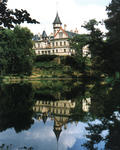 The district town of Opava
The district town of Opava (with a population of 64,000) is situated on the River Opava, c. 260m above sea level. It is an important industrial and cultural centre for Czech Silesia and its importance extends beyond district borders.
The first written record of a settlement at a point where trading roads crossed, named after the River Opava, dates from 1195. The status of the town is documented by a deed from the year 1224.
The principality of Opava was founded under the Czech crown at the beginning of the 14
th century, and the town of Opava became its administrative centre. After the lost war of 1742, when a great part of Silesia was ceded to Prussia, Opava became capital of Austrian Silesia.
In 1820, after Napoleon had been defeated, the victorious powers held their second conference in Opava. Here, the representatives of the
"Holy Alliance" - the Russian czar, the Prussian king, the Austrian emperor and representatives from England and France - held meetings on common policy in the face of the revolutionary movement in Italy. Opava was the seat of the provincial offices until the formation of the province of Moravia-Silesia in 1928.
Opava was not marked by great industrial development, and its inhabitants were heavily Germanized. The Czech national movement grew in strength in the second half of the 19
th century and Opava became its centre. But only with the formation of the Czechoslovak Republic in 1918 were the Czech political consciousness and Czech culture in Silesia able to flourish.

The railway connection in 1855 revived - although not to a dramatic extent - the stagnating economy, in particular the spinning industry and later the food industry.
During
the Nazi occupation of 1938 - 1945 Opava was the centre of one of the Sudeten districts. Opava was badly damaged in heavy fighting in the last weeks of the Second World War, in the course of which 3,000 Soviet soldiers lost their lives.
After the war, whole new areas of the town were built together with many new factories - the latter being mainly used for the engineering, food, paper and pharmaceutical industries. Today, Opava is a town by statute and the seat of the Silesian University. There are many secondary schools, as well as cultural and scientific instituions: for example, the Silesian State Museum (founded on May 1,1814), which is the oldest museum in this country a nd is one of the most important institutions in the Czech Republic (contents include permanent exhibitions on the history and natural history of Silesia; life and culture from the Gothic period to the present day). The Silesian Institute and the site of the Archeological Institute of the Czech Academy of Science also have their headquarters in Opava.
Opava is the native town of
the poet Petr Bezruc (1867 - 1958), who is also buried here. J. G. Mendel (1822 - 1884), the father of modern genetics, studied at Opava's grammar school. Other famous natives of the town include: the architect J. M. Olbrich (1867 - 1908), a co-founder of Viennese secession; the writer A. C. Nor (1903 - 1986); and Joy Adamson (1910 - 1980), an enthusiastic fighter for the saving of wildlife in Africa and the author of books about Elsa the lioness.
There are many well-preserved historical sights in Opava, many of which are protected by the State Office for the Protection of Historical Monuments. The poet Petr Bezruc called the town
"White Opava" because of its many parks and green areas, concentrated especially on the periphery of the historical town centre.



 Guide
Guide 





